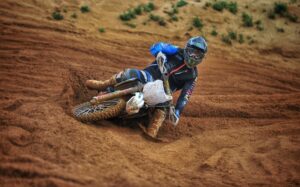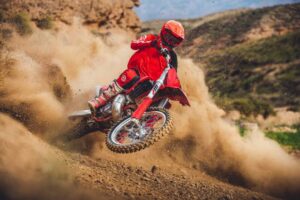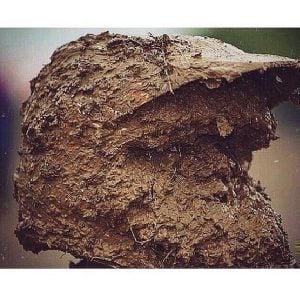We are reader-supported. When you buy through links on our site, we may earn an affiliate commission. Learn More…
New on the Bike: 5 Dirt Bike Riding Mistakes Beginners Make
I’ve been riding dirt bikes since the young age of four years old. In the beginning, I spent a lot of time crashing and pushing my kids dirt bike up from the dirt and made so many dirt bike riding mistakes. There were a lot of trips that I wanted to quit, give up riding but my best riding days occurred when I focused on the techniques of proper form, balance, and learning to read the terrain.
When you are first learning to ride a dirt bike, repetitive practice of very basic dirt bike riding techniques will create muscle memory for your future riding career. As you become a more experienced on a dirt bike, changing bad habits will be increasingly harder so it is important to nip them in the butt now.
As a new dirt bike rider, look over these five dirt bike riding mistakes beginners make and keep them in your conscious as you ride.
1. Improper Form – Dirt Bike Riding Mistakes
Don’t be a squid! Proper stance and seat positioning not only can compromise your style but sets you up for a crash. A rider should sit on their dirt bike in the following body position:
- Balls of your feet on the foot pegs.
- Knees are squeezing the gas tank straight above your toes.
- Elbows are up and out at right angle, lateral with your chest.
- “Nuts on the tank”
Always try to ride on the balls of your feet and slide the feet forward only enough to reach the shift lever brake and the back-brake lever. The back brake can be the most difficult for a new rider to reach but your foot needs to be close enough so you do not have to pick up your foot and potentially stab or drag the brake. This can send the back tire out from under you in a skid.
On the left side you’ll find that your left foot needs to be go under the shift lever to shift into a higher gear and pushing the lever downward to downshift. If your foot is too far forward, a bump in your ride can knock your foot down and shift back into a lower gear unwillingly.
Above your feet, your knees will be squeezing the side of the bike. This is most important in a standing position. Squeezing the bike will aid in aligning your body position from top to bottom and increase your overall body control of the dirt bike.
ELBOWS UP! ELBOWS UP!
If you forget any of these other body positions, this is the most important to implement. Keep your elbows up over a ninety-degree angle and lateral with your chest. Dropping your elbows by your sides eliminates your control of the dirt bike and your ability to control it over an obstacle.
It’s simple trigonometry. The over ninety-degree, right angle is the strongest of the spectrum. An open angle, where you would extend your elbows allowing them to be vertical with the handlebars, opens your control of the of the dirt bike. The right angle of your elbows allows you to engage your shoulders, biceps, and forearms to control the dirt bike.
All of these muscles need to build the endurance and strength to ride for extended times. Elbows need to stay up in turns, straightaways, and when standing up on the dirt bike.
“Nuts on the tank”
Figuratively speaking, of course, this article is written by a female dirt bike rider, placing your pelvis as far forward on the seat helps you make sure all the other positions are aligned. When you sit forward on the dirt bike, your weight is evenly distributed and center of gravity is above the motor. Here you can control your weight distribution and keep the front wheel on the ground.
Good positioning on your dirt bike will let you ride the bike instead of the bike riding you. Improper placement can quickly fatigue your body on a dirt bike ride. Make sure you are concentrating on keeping up all of these points and you will establish positive muscle memory. It will be second nature on your ride!
2. Choose Your Gears Wisely
For most dirt bike riding mistakes on the trail, I find that dirt bike riders are usually in the incorrect gear. Dirt bike beginners need to be able to utilize the power of their dirt bike to get through obstacles and this can only be achieved if they understand how to shift through the gears.
In a situation when the dirt bike needs to go from a wider trailhead to tighter turn, for example, the bike must be downshifted to a lower gear to keep the rotations up on the motor (RPM). When the motor is rotating, power can be quickly generated when requested from the throttle. When a rider has significantly slowed down for that tighter turn, they will downshift a gear or two, twist the throttle, and have enough power to cruise out of it.
Learn to listen your dirt bike
When a dirt bike motor is not in the proper gear, the throttle response will be limited and the motor is not able to respond with power. This is when the motor will stall out, turning off the bike.
Being in the correct gear the dirt bike rider can utilize power to get up to a faster speed or challenge themselves to a new obstacle. A very vertical, sandy hill climb will absolutely require the rider to be in the right low gear.
The best way to practice choosing the right gear is to listen to the motor. High RPMs, loud motor will mean it is time to shift to a different gear. Low RPMs, a bogging of the motor recognizes you’re in the wrong gear and need to downshift. Get used to listening to your dirt bike’s motor as it will be able to tell you when you need to shift.
3. Steady as You Ride
As a beginner learning to ride a dirt bike, the new weight of the bike can compromise your sense of balance. The center of gravity on a dirt bike is right below your seat where the frame surrounds the motor. You need to be able to find your balance on a dirt bike similar to the feeling of when you first rode a bicycle.
There will be situations on a ride where you will need to slow down to get through a tight environment. You cannot rely on the power to always keep you upright.
During the first couple rides, you will feel the need to want to sit down through the ride. In the beginning, this is ok and the best safety practice so that you don’t ride beyond your experience level.
Practice Your Balance on the Bike
To practice balance, make sure to remember your proper riding placement as discussed above and simply ride at low speeds with both feet ready to be put down on the ground so you don’t topple over. If you start to fall, put your foot down and stop the dirt bike. More seat time will only help you find your balance quickly and before you know it, you won’t need to think about it as it will come naturally.
As you progress to jumping or going through continuous whoops, you will find that sitting on the dirt bike is not efficient for your speed or body. Standing up on the foot pegs with your elbows out and hips rolled forward will put you into attack mode on any obstacle. Remember to try to keep your center of gravity all in line with the motor beneath you. This will require balance but is imperative when allowing the dirt bike to take most of the abuse.
4. LOOK! Read Your Terrain
The motor in your dirt bike will allow you to travel at speeds you may have not approached before. This also means that obstacles come up a lot quicker than before. Also, as speeds go up, stopping distance dramatically increases. You need to be alert at all times and prepare for the worst-case scenario.
When you are riding, you need to be looking forward and reading the terrain even further. Do not concentrate on what your front tire will hit now, look ahead and determine what it will encounter in three seconds. Planning ahead lets you ride more efficiently and safer.
If you see a huge boulder right in front of your tire now, it’s too late! You need to see that boulder three seconds ahead so you can prepare your body positioning to either brake, slow down, or simply just move to the side.
Constantly Look Ahead From Your Dirt Bike
In an earlier article, I talked about keeping your head on a swivel when riding your dirt bike. This means you need to always be scanning the environment in front of you and also in your peripheral, side vision. Depending upon your local riding, upcoming hazards like a fence or other riders can be hidden by the environment. I recently did some riding in Northern California High Sierra Mountains where all the trails are surrounded by tall pine trees. I had to adjust my riding speeds based on the lack of visibility.
Another sense of dirt bike riding awareness is your ability to read terrain. This is a skill that can only be taught by experience and riding your dirt bike in various different terrains. You will find that your dirt bike reacts to sand a different way than hard packed dirt and you need to be prepared for that reaction on the ride.
Dirt is not consistent and trails are ever-changing even if you’ve ridden there before. For instance after a rainstorm, corners can become rutted from pooling water and whoops will have squared edges, a recipe for a crash when not prepared. You will learn to take the path of least resistance to have a smooth ride on your dirt bike.
5. Throw Fear to the Wind
I will tell you right now, you’re going to crash. Topple over, lose your balance, hit a rock, it is going to happen! You need to let go of the fear of crashing because it will inevitably happen to you. The thrill of riding a dirt bike can also be a fear factor for many riders.
Learning to ride faster and through tougher obstacles is the payoff for those crashes.
One of the most frustrating factors for me as a new rider was shifting the dirt bike and making sure I was in the right gear. I would stall out and get so frustrated because I had to kickstart my dirt bike back over and start from the beginning. Let’s not even talk about how many times I struggled on picking my bike up from the dirt!
Do Not Fear Crashing!
It’s going to happen. My best advice is to relax and be patient when developing your dirt bike riding technique. Being frustrated or nervous only compounds the challenges you face and you can’t focus on your riding.
Ride with a group that is going to support you. Every dirt bike rider was a newbie at one time! Let your riding group give you some criticism because it will only help your abilities.
Enjoy the Ride!
Keep these five common dirt bike riding mistakes in your mind and focus on the skills that can help build away from them. In dirt bike riding along with any other ability, repetition is the key! Spending time on the seat of your dirt bike will only increase your ability to ride faster, smarter, and safer! Also, you might want to subscribe to a dirt bike course, there are plenty of options, but make sure you click on that “Learn” button on the top right menu of this site!
Oh, and keep those elbows up!






Wow! Thank you!!! This is by far the best advice article I’ve read
I was able to spot some of the mistakes I’ve been making and also be proud of the things I do “naturally” well, like the position of my elbows.
I’m a woman and knowing that this great advices came from another woman has encouraged me to try harder and wiser on my dirt biking. Best regards!!!
Hello everyone on this forum – thanks.
My name is Mark and i am from luxembourg
best regards 🙂